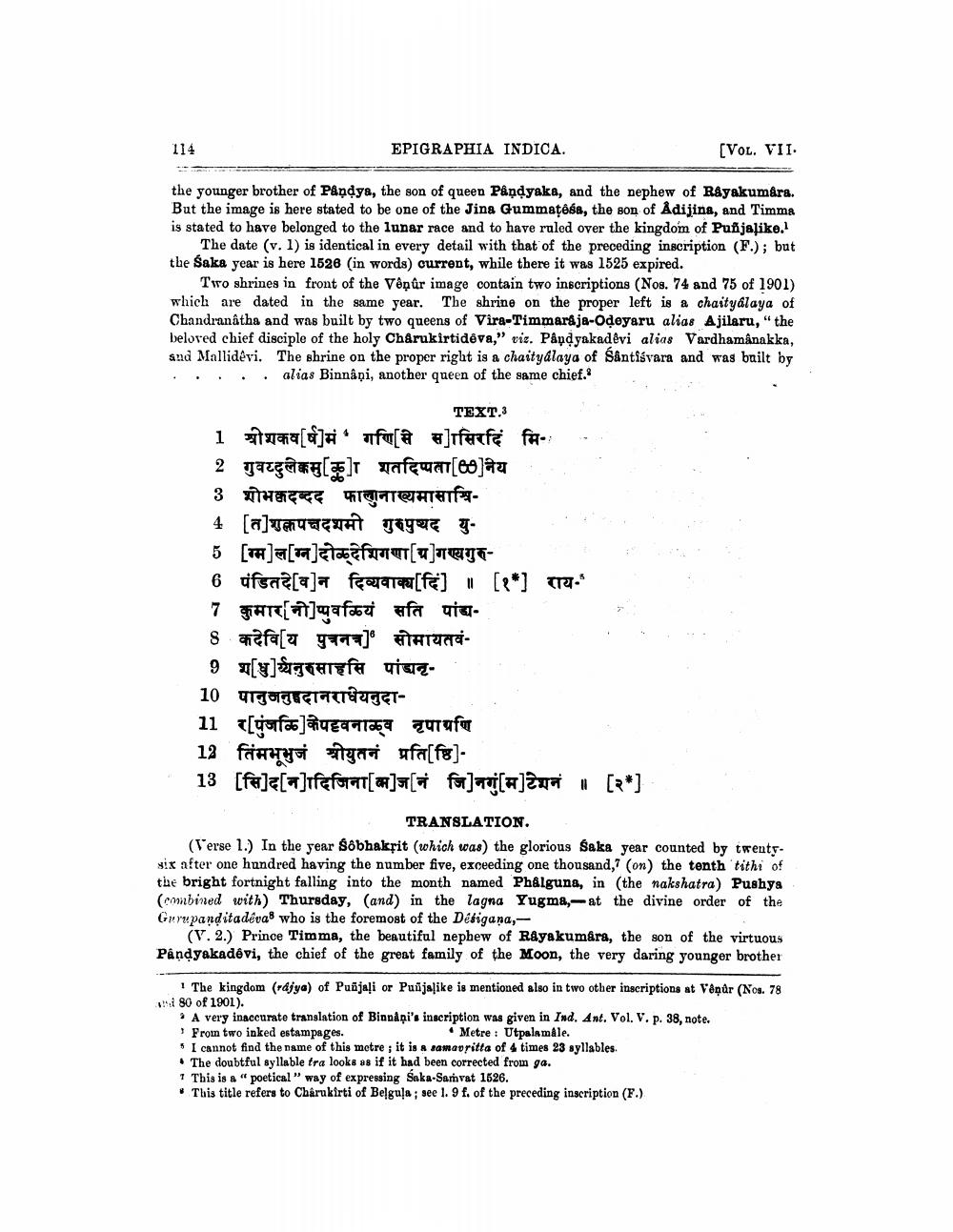________________
114
EPIGRAPHIA INDICA.
[VOL. VII.
the younger brother of Pandya, the son of queen Pandyaka, and the nephew of Râyakumara. But the image is here stated to be one of the Jina Gummatesa, the son of Adijina, and Timma is stated to have belonged to the lunar race and to have ruled over the kingdom of Puñjalike.1
The date (v. 1) is identical in every detail with that of the preceding inscription (F.); but the Saka year is here 1526 (in words) current, while there it was 1525 expired.
Two shrines in front of the Vênûr image contain two inscriptions (Nos. 74 and 75 of 1901) which are dated in the same year. The shrine on the proper left is a chaityalaya of Chandranatha and was built by two queens of Vira-Timmaraja-Oḍeyaru alias Ajilaru, "the beloved chief disciple of the holy Chârukirtideva," viz. Pânḍyakadêvi alias Vardhamânakka, and Mallidêvi. The shrine on the proper right is a chaityalaya of Śântiśvara and was built by .. alias Binnâņi, another queen of the same chief.
TEXT.3
1 श्रीशकव[र्ष ]मं गणि[से स]ासिरदिं मि 2 गुवटुलेकमु [ कु] शतदिष्यता [60] नय 3 शोभक्कदब्दद फाल्गुनाख्यमासाश्रि
4 [H] शुक्लपचदममी गुरुपुचद यु.
5 [म] [[न] दोळ्देशिगणा [अ] गणगुरु
6 पंडितदे [व]न दिव्यवाक्य [दिं] ॥ [१* ] राय-'
7 कुमार[नो ]प्पुवक्रियं सति पांड्य
8 कदेवि [य पुत्रनत्र ] सोमायतवं
9 [य][४] गुरुसाहसि पांड्यनु
10 पानुजनुदानराधेयनुदा - 11 [ पुंजकि] के पहवना 12 तिंमभूभुजं श्रीयुतनं प्रति [[ष्ठि) -
नृपाणि ]
13 [सि] [न]]दिजिना [का] ज[नं जि]नगुं[म]टेशनं । [२]
TRANSLATION.
(Verse 1) In the year Sobhakrit (which was) the glorious Saka year counted by twentysix after one hundred having the number five, exceeding one thousand,7 (on) the tenth tithi of the bright fortnight falling into the month named Phalguna, in (the nakshatra) Pushya (combined with) Thursday, (and) in the lagna Yugma,-at the divine order of the Gurupanditadeva who is the foremost of the Désigana,
(V. 2.) Prince Timma, the beautiful nephew of Rayakumara, the son of the virtuous Pandyakadevi, the chief of the great family of the Moon, the very daring younger brother
The kingdom (rajya) of Puñjali or Puñjalike is mentioned also in two other inscriptions at Vênûr (Nos. 78 d 80 of 1901).
A very inaccurate translation of Binnapi's inscription was given in Ind. Ant. Vol. V. p. 38, note. From two inked estampages. Metre Utpalamâle.
5 I cannot find the name of this metre; it is a samavritta of 4 times 23 syllables.
The doubtful syllable tra looks as if it had been corrected from ga.
7 This is a "poetical" way of expressing Saka-Samvat 1526.
This title refers to Charukirti of Belgula; see 1. 9 f. of the preceding inscription (F.)




